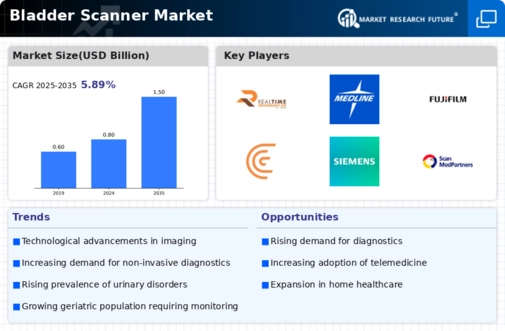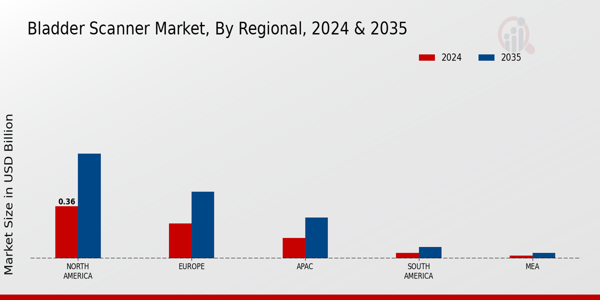-
EXECUTIVE SUMMARY
-
Market Overview
-
Key Findings
-
Market Segmentation
-
Competitive Landscape
-
Challenges and Opportunities
-
Future Outlook
-
MARKET INTRODUCTION
-
Definition
-
Scope of the study
- Research Objective
- Assumption
- Limitations
-
RESEARCH METHODOLOGY
-
Overview
-
Data Mining
-
Secondary Research
-
Primary Research
-
Primary Interviews and Information Gathering Process
-
Breakdown of Primary
-
Respondents
-
Forecasting Model
-
Market Size Estimation
-
Bottom-Up Approach
-
Top-Down Approach
-
Data Triangulation
-
Validation
-
MARKET DYNAMICS
-
Overview
-
Drivers
-
Restraints
-
Opportunities
-
MARKET FACTOR ANALYSIS
-
Value chain Analysis
-
Porter's Five Forces
-
Analysis
-
Bargaining Power of Suppliers
- Bargaining Power
-
of Buyers
-
Threat of New Entrants
- Threat of Substitutes
- Intensity of Rivalry
-
COVID-19 Impact Analysis
-
Market Impact Analysis
-
Regional Impact
- Opportunity and
-
Threat Analysis
-
BLADDER SCANNER MARKET, BY PRODUCT TYPE
-
(USD BILLION)
-
Portable Bladder Scanners
-
Fixed Bladder Scanners
-
Tabletop Bladder Scanners
-
BLADDER SCANNER MARKET, BY TECHNOLOGY
-
(USD BILLION)
-
Ultrasound Technology
-
Laser Technology
-
Electric Technology
-
BLADDER SCANNER MARKET, BY END USER (USD BILLION)
-
Hospitals
-
Clinics
-
Home Care
-
BLADDER SCANNER
-
MARKET, BY APPLICATION (USD BILLION)
-
Urology
-
Gynecology
-
Pediatrics
-
BLADDER SCANNER MARKET, BY REGIONAL (USD BILLION)
-
North America
- US
- Canada
-
Europe
- Germany
- UK
- France
- Russia
- Italy
- Spain
- Rest of Europe
-
APAC
- China
- India
- Japan
- South
-
Korea
-
Malaysia
- Thailand
- Indonesia
- Rest of APAC
-
South America
- Brazil
-
Mexico
-
Argentina
- Rest of South America
-
MEA
- GCC Countries
- South Africa
- Rest of MEA
-
COMPETITIVE LANDSCAPE
-
Overview
-
Competitive Analysis
-
Market share Analysis
-
Major Growth
-
Strategy in the Bladder Scanner Market
-
Competitive Benchmarking
-
Leading Players in Terms of Number of Developments in the Bladder Scanner
-
Market
-
Key developments and growth strategies
- New Product
-
Launch/Service Deployment
-
Merger & Acquisitions
-
Joint Ventures
-
Major Players Financial Matrix
- Sales and
-
Operating Income
-
Major Players R&D Expenditure. 2023
-
COMPANY PROFILES
-
GE Healthcare
- Financial Overview
- Products Offered
- Key Developments
- SWOT Analysis
- Key Strategies
-
Realtime Technology
- Financial
-
Overview
-
Products Offered
- Key Developments
-
SWOT Analysis
-
Key Strategies
-
Medline Industries
-
Financial Overview
-
Products Offered
- Key Developments
- SWOT Analysis
- Key Strategies
-
Bracco Imaging
- Financial Overview
- Products Offered
- Key
-
Developments
-
SWOT Analysis
- Key Strategies
-
Fujifilm Holdings
-
Financial Overview
- Products Offered
- Key Developments
- SWOT Analysis
- Key Strategies
-
Aton Medical
- Financial Overview
- Products
-
Offered
-
Key Developments
- SWOT Analysis
-
Key Strategies
-
Clarius Mobile Health
- Financial Overview
- Products Offered
- Key Developments
- SWOT
-
Analysis
-
Key Strategies
-
Siemens
- Financial
-
Overview
-
Products Offered
- Key Developments
-
SWOT Analysis
-
Key Strategies
-
ScanMed
- Financial
-
Overview
-
Products Offered
- Key Developments
-
SWOT Analysis
-
Key Strategies
-
Hologic
- Financial
-
Overview
-
Products Offered
- Key Developments
-
SWOT Analysis
-
Key Strategies
-
Dentra Health
-
Financial Overview
-
Products Offered
- Key Developments
- SWOT Analysis
- Key Strategies
-
Cure Medical
- Financial Overview
- Products Offered
-
Key Developments
-
SWOT Analysis
- Key Strategies
-
Caresono
- Financial Overview
- Products Offered
- Key Developments
- SWOT Analysis
- Key
-
Strategies
-
Urovo Technology
- Financial Overview
-
Products Offered
-
Key Developments
- SWOT Analysis
- Key Strategies
-
Philips
- Financial Overview
- Products Offered
- Key Developments
- SWOT
-
Analysis
-
Key Strategies
-
APPENDIX
-
References
-
Related Reports
-
BY PRODUCT TYPE, 2019-2035 (USD BILLIONS)
-
MARKET SIZE ESTIMATES & FORECAST, BY TECHNOLOGY, 2019-2035 (USD BILLIONS)
-
END USER, 2019-2035 (USD BILLIONS)
-
MARKET SIZE ESTIMATES & FORECAST, BY APPLICATION, 2019-2035 (USD BILLIONS)
-
REGIONAL, 2019-2035 (USD BILLIONS)
-
ESTIMATES & FORECAST, BY PRODUCT TYPE, 2019-2035 (USD BILLIONS)
-
US BLADDER SCANNER MARKET SIZE ESTIMATES & FORECAST, BY TECHNOLOGY, 2019-2035
-
(USD BILLIONS)
-
BY END USER, 2019-2035 (USD BILLIONS)
-
SIZE ESTIMATES & FORECAST, BY APPLICATION, 2019-2035 (USD BILLIONS)
-
US BLADDER SCANNER MARKET SIZE ESTIMATES & FORECAST, BY REGIONAL, 2019-2035
-
(USD BILLIONS)
-
FORECAST, BY PRODUCT TYPE, 2019-2035 (USD BILLIONS)
-
SCANNER MARKET SIZE ESTIMATES & FORECAST, BY TECHNOLOGY, 2019-2035 (USD BILLIONS)
-
END USER, 2019-2035 (USD BILLIONS)
-
SIZE ESTIMATES & FORECAST, BY APPLICATION, 2019-2035 (USD BILLIONS)
-
CANADA BLADDER SCANNER MARKET SIZE ESTIMATES & FORECAST, BY REGIONAL, 2019-2035
-
(USD BILLIONS)
-
FORECAST, BY PRODUCT TYPE, 2019-2035 (USD BILLIONS)
-
SCANNER MARKET SIZE ESTIMATES & FORECAST, BY TECHNOLOGY, 2019-2035 (USD BILLIONS)
-
END USER, 2019-2035 (USD BILLIONS)
-
SIZE ESTIMATES & FORECAST, BY APPLICATION, 2019-2035 (USD BILLIONS)
-
EUROPE BLADDER SCANNER MARKET SIZE ESTIMATES & FORECAST, BY REGIONAL, 2019-2035
-
(USD BILLIONS)
-
FORECAST, BY PRODUCT TYPE, 2019-2035 (USD BILLIONS)
-
SCANNER MARKET SIZE ESTIMATES & FORECAST, BY TECHNOLOGY, 2019-2035 (USD BILLIONS)
-
END USER, 2019-2035 (USD BILLIONS)
-
SIZE ESTIMATES & FORECAST, BY APPLICATION, 2019-2035 (USD BILLIONS)
-
GERMANY BLADDER SCANNER MARKET SIZE ESTIMATES & FORECAST, BY REGIONAL, 2019-2035
-
(USD BILLIONS)
-
BY PRODUCT TYPE, 2019-2035 (USD BILLIONS)
-
SIZE ESTIMATES & FORECAST, BY TECHNOLOGY, 2019-2035 (USD BILLIONS)
-
UK BLADDER SCANNER MARKET SIZE ESTIMATES & FORECAST, BY END USER, 2019-2035
-
(USD BILLIONS)
-
BY APPLICATION, 2019-2035 (USD BILLIONS)
-
SIZE ESTIMATES & FORECAST, BY REGIONAL, 2019-2035 (USD BILLIONS)
-
FRANCE BLADDER SCANNER MARKET SIZE ESTIMATES & FORECAST, BY PRODUCT TYPE,
-
2035 (USD BILLIONS)
-
& FORECAST, BY TECHNOLOGY, 2019-2035 (USD BILLIONS)
-
SCANNER MARKET SIZE ESTIMATES & FORECAST, BY END USER, 2019-2035 (USD BILLIONS)
-
APPLICATION, 2019-2035 (USD BILLIONS)
-
SIZE ESTIMATES & FORECAST, BY REGIONAL, 2019-2035 (USD BILLIONS)
-
RUSSIA BLADDER SCANNER MARKET SIZE ESTIMATES & FORECAST, BY PRODUCT TYPE,
-
2035 (USD BILLIONS)
-
& FORECAST, BY TECHNOLOGY, 2019-2035 (USD BILLIONS)
-
SCANNER MARKET SIZE ESTIMATES & FORECAST, BY END USER, 2019-2035 (USD BILLIONS)
-
APPLICATION, 2019-2035 (USD BILLIONS)
-
SIZE ESTIMATES & FORECAST, BY REGIONAL, 2019-2035 (USD BILLIONS)
-
ITALY BLADDER SCANNER MARKET SIZE ESTIMATES & FORECAST, BY PRODUCT TYPE,
-
2035 (USD BILLIONS)
-
& FORECAST, BY TECHNOLOGY, 2019-2035 (USD BILLIONS)
-
SCANNER MARKET SIZE ESTIMATES & FORECAST, BY END USER, 2019-2035 (USD BILLIONS)
-
2035 (USD BILLIONS)
-
& FORECAST, BY REGIONAL, 2019-2035 (USD BILLIONS)
-
SCANNER MARKET SIZE ESTIMATES & FORECAST, BY PRODUCT TYPE, 2019-2035 (USD BILLIONS)
-
2035 (USD BILLIONS)
-
& FORECAST, BY END USER, 2019-2035 (USD BILLIONS)
-
SCANNER MARKET SIZE ESTIMATES & FORECAST, BY APPLICATION, 2019-2035 (USD BILLIONS)
-
2035 (USD BILLIONS)
-
ESTIMATES & FORECAST, BY PRODUCT TYPE, 2019-2035 (USD BILLIONS)
-
REST OF EUROPE BLADDER SCANNER MARKET SIZE ESTIMATES & FORECAST, BY TECHNOLOGY,
-
2035 (USD BILLIONS)
-
ESTIMATES & FORECAST, BY END USER, 2019-2035 (USD BILLIONS)
-
REST OF EUROPE BLADDER SCANNER MARKET SIZE ESTIMATES & FORECAST, BY APPLICATION,
-
2035 (USD BILLIONS)
-
ESTIMATES & FORECAST, BY REGIONAL, 2019-2035 (USD BILLIONS)
-
APAC BLADDER SCANNER MARKET SIZE ESTIMATES & FORECAST, BY PRODUCT TYPE, 2019-2035
-
(USD BILLIONS)
-
FORECAST, BY TECHNOLOGY, 2019-2035 (USD BILLIONS)
-
MARKET SIZE ESTIMATES & FORECAST, BY END USER, 2019-2035 (USD BILLIONS)
-
2035 (USD BILLIONS)
-
& FORECAST, BY REGIONAL, 2019-2035 (USD BILLIONS)
-
SCANNER MARKET SIZE ESTIMATES & FORECAST, BY PRODUCT TYPE, 2019-2035 (USD BILLIONS)
-
2035 (USD BILLIONS)
-
& FORECAST, BY END USER, 2019-2035 (USD BILLIONS)
-
SCANNER MARKET SIZE ESTIMATES & FORECAST, BY APPLICATION, 2019-2035 (USD BILLIONS)
-
2035 (USD BILLIONS)
-
& FORECAST, BY PRODUCT TYPE, 2019-2035 (USD BILLIONS)
-
BLADDER SCANNER MARKET SIZE ESTIMATES & FORECAST, BY TECHNOLOGY, 2019-2035 (USD
-
BILLIONS)
-
BY END USER, 2019-2035 (USD BILLIONS)
-
SIZE ESTIMATES & FORECAST, BY APPLICATION, 2019-2035 (USD BILLIONS)
-
INDIA BLADDER SCANNER MARKET SIZE ESTIMATES & FORECAST, BY REGIONAL, 2019-2035
-
(USD BILLIONS)
-
FORECAST, BY PRODUCT TYPE, 2019-2035 (USD BILLIONS)
-
SCANNER MARKET SIZE ESTIMATES & FORECAST, BY TECHNOLOGY, 2019-2035 (USD BILLIONS)
-
USER, 2019-2035 (USD BILLIONS)
-
ESTIMATES & FORECAST, BY APPLICATION, 2019-2035 (USD BILLIONS)
-
JAPAN BLADDER SCANNER MARKET SIZE ESTIMATES & FORECAST, BY REGIONAL, 2019-2035
-
(USD BILLIONS)
-
& FORECAST, BY PRODUCT TYPE, 2019-2035 (USD BILLIONS)
-
KOREA BLADDER SCANNER MARKET SIZE ESTIMATES & FORECAST, BY TECHNOLOGY, 2019-2035
-
(USD BILLIONS)
-
& FORECAST, BY END USER, 2019-2035 (USD BILLIONS)
-
BLADDER SCANNER MARKET SIZE ESTIMATES & FORECAST, BY APPLICATION, 2019-2035
-
(USD BILLIONS)
-
& FORECAST, BY REGIONAL, 2019-2035 (USD BILLIONS)
-
SCANNER MARKET SIZE ESTIMATES & FORECAST, BY PRODUCT TYPE, 2019-2035 (USD BILLIONS)
-
TECHNOLOGY, 2019-2035 (USD BILLIONS)
-
SIZE ESTIMATES & FORECAST, BY END USER, 2019-2035 (USD BILLIONS)
-
MALAYSIA BLADDER SCANNER MARKET SIZE ESTIMATES & FORECAST, BY APPLICATION,
-
2035 (USD BILLIONS)
-
& FORECAST, BY REGIONAL, 2019-2035 (USD BILLIONS)
-
SCANNER MARKET SIZE ESTIMATES & FORECAST, BY PRODUCT TYPE, 2019-2035 (USD BILLIONS)
-
TECHNOLOGY, 2019-2035 (USD BILLIONS)
-
SIZE ESTIMATES & FORECAST, BY END USER, 2019-2035 (USD BILLIONS)
-
THAILAND BLADDER SCANNER MARKET SIZE ESTIMATES & FORECAST, BY APPLICATION,
-
2035 (USD BILLIONS)
-
& FORECAST, BY REGIONAL, 2019-2035 (USD BILLIONS)
-
BLADDER SCANNER MARKET SIZE ESTIMATES & FORECAST, BY PRODUCT TYPE, 2019-2035
-
(USD BILLIONS)
-
FORECAST, BY TECHNOLOGY, 2019-2035 (USD BILLIONS)
-
SCANNER MARKET SIZE ESTIMATES & FORECAST, BY END USER, 2019-2035 (USD BILLIONS)
-
BY APPLICATION, 2019-2035 (USD BILLIONS)
-
MARKET SIZE ESTIMATES & FORECAST, BY REGIONAL, 2019-2035 (USD BILLIONS)
-
PRODUCT TYPE, 2019-2035 (USD BILLIONS)
-
MARKET SIZE ESTIMATES & FORECAST, BY TECHNOLOGY, 2019-2035 (USD BILLIONS)
-
END USER, 2019-2035 (USD BILLIONS)
-
MARKET SIZE ESTIMATES & FORECAST, BY APPLICATION, 2019-2035 (USD BILLIONS)
-
BY REGIONAL, 2019-2035 (USD BILLIONS)
-
MARKET SIZE ESTIMATES & FORECAST, BY PRODUCT TYPE, 2019-2035 (USD BILLIONS)
-
BY TECHNOLOGY, 2019-2035 (USD BILLIONS)
-
MARKET SIZE ESTIMATES & FORECAST, BY END USER, 2019-2035 (USD BILLIONS)
-
BY APPLICATION, 2019-2035 (USD BILLIONS)
-
SCANNER MARKET SIZE ESTIMATES & FORECAST, BY REGIONAL, 2019-2035 (USD BILLIONS)
-
PRODUCT TYPE, 2019-2035 (USD BILLIONS)
-
SIZE ESTIMATES & FORECAST, BY TECHNOLOGY, 2019-2035 (USD BILLIONS)
-
BRAZIL BLADDER SCANNER MARKET SIZE ESTIMATES & FORECAST, BY END USER, 2019-2035
-
(USD BILLIONS)
-
FORECAST, BY APPLICATION, 2019-2035 (USD BILLIONS)
-
SCANNER MARKET SIZE ESTIMATES & FORECAST, BY REGIONAL, 2019-2035 (USD BILLIONS)
-
PRODUCT TYPE, 2019-2035 (USD BILLIONS)
-
SIZE ESTIMATES & FORECAST, BY TECHNOLOGY, 2019-2035 (USD BILLIONS)
-
MEXICO BLADDER SCANNER MARKET SIZE ESTIMATES & FORECAST, BY END USER, 2019-2035
-
(USD BILLIONS)
-
FORECAST, BY APPLICATION, 2019-2035 (USD BILLIONS)
-
SCANNER MARKET SIZE ESTIMATES & FORECAST, BY REGIONAL, 2019-2035 (USD BILLIONS)
-
BY PRODUCT TYPE, 2019-2035 (USD BILLIONS)
-
MARKET SIZE ESTIMATES & FORECAST, BY TECHNOLOGY, 2019-2035 (USD BILLIONS)
-
END USER, 2019-2035 (USD BILLIONS)
-
SIZE ESTIMATES & FORECAST, BY APPLICATION, 2019-2035 (USD BILLIONS)
-
ARGENTINA BLADDER SCANNER MARKET SIZE ESTIMATES & FORECAST, BY REGIONAL,
-
2035 (USD BILLIONS)
-
MARKET SIZE ESTIMATES & FORECAST, BY PRODUCT TYPE, 2019-2035 (USD BILLIONS)
-
FORECAST, BY TECHNOLOGY, 2019-2035 (USD BILLIONS)
-
AMERICA BLADDER SCANNER MARKET SIZE ESTIMATES & FORECAST, BY END USER, 2019-2035
-
(USD BILLIONS)
-
ESTIMATES & FORECAST, BY APPLICATION, 2019-2035 (USD BILLIONS)
-
REST OF SOUTH AMERICA BLADDER SCANNER MARKET SIZE ESTIMATES & FORECAST, BY REGIONAL,
-
2035 (USD BILLIONS)
-
& FORECAST, BY PRODUCT TYPE, 2019-2035 (USD BILLIONS)
-
SCANNER MARKET SIZE ESTIMATES & FORECAST, BY TECHNOLOGY, 2019-2035 (USD BILLIONS)
-
USER, 2019-2035 (USD BILLIONS)
-
ESTIMATES & FORECAST, BY APPLICATION, 2019-2035 (USD BILLIONS)
-
MEA BLADDER SCANNER MARKET SIZE ESTIMATES & FORECAST, BY REGIONAL, 2019-2035
-
(USD BILLIONS)
-
& FORECAST, BY PRODUCT TYPE, 2019-2035 (USD BILLIONS)
-
BLADDER SCANNER MARKET SIZE ESTIMATES & FORECAST, BY TECHNOLOGY, 2019-2035 (USD
-
BILLIONS)
-
FORECAST, BY END USER, 2019-2035 (USD BILLIONS)
-
SCANNER MARKET SIZE ESTIMATES & FORECAST, BY APPLICATION, 2019-2035 (USD BILLIONS)
-
BY REGIONAL, 2019-2035 (USD BILLIONS)
-
MARKET SIZE ESTIMATES & FORECAST, BY PRODUCT TYPE, 2019-2035 (USD BILLIONS)
-
BY TECHNOLOGY, 2019-2035 (USD BILLIONS)
-
MARKET SIZE ESTIMATES & FORECAST, BY END USER, 2019-2035 (USD BILLIONS)
-
BY APPLICATION, 2019-2035 (USD BILLIONS)
-
MARKET SIZE ESTIMATES & FORECAST, BY REGIONAL, 2019-2035 (USD BILLIONS)
-
PRODUCT TYPE, 2019-2035 (USD BILLIONS)
-
MARKET SIZE ESTIMATES & FORECAST, BY TECHNOLOGY, 2019-2035 (USD BILLIONS)
-
END USER, 2019-2035 (USD BILLIONS)
-
MARKET SIZE ESTIMATES & FORECAST, BY APPLICATION, 2019-2035 (USD BILLIONS)
-
REGIONAL, 2019-2035 (USD BILLIONS)
-
ANALYSIS
-
BLADDER SCANNER MARKET ANALYSIS BY END USER
-
ANALYSIS BY APPLICATION
-
CANADA BLADDER SCANNER MARKET ANALYSIS BY TECHNOLOGY
-
BLADDER SCANNER MARKET ANALYSIS BY END USER
-
MARKET ANALYSIS BY APPLICATION
-
BY REGIONAL
-
GERMANY BLADDER SCANNER MARKET ANALYSIS BY PRODUCT TYPE
-
BLADDER SCANNER MARKET ANALYSIS BY TECHNOLOGY
-
MARKET ANALYSIS BY END USER
-
BY APPLICATION
-
UK BLADDER SCANNER MARKET ANALYSIS BY TECHNOLOGY
-
SCANNER MARKET ANALYSIS BY END USER
-
BY APPLICATION
-
FRANCE BLADDER SCANNER MARKET ANALYSIS BY TECHNOLOGY
-
BLADDER SCANNER MARKET ANALYSIS BY END USER
-
MARKET ANALYSIS BY APPLICATION
-
BY REGIONAL
-
RUSSIA BLADDER SCANNER MARKET ANALYSIS BY END USER
-
SCANNER MARKET ANALYSIS BY APPLICATION
-
ANALYSIS BY REGIONAL
-
TYPE
-
ITALY BLADDER SCANNER MARKET ANALYSIS BY END USER
-
SCANNER MARKET ANALYSIS BY APPLICATION
-
ANALYSIS BY REGIONAL
-
TYPE
-
SPAIN BLADDER SCANNER MARKET ANALYSIS BY END USER
-
SCANNER MARKET ANALYSIS BY APPLICATION
-
ANALYSIS BY REGIONAL
-
BY PRODUCT TYPE
-
BY TECHNOLOGY
-
END USER
-
SCANNER MARKET ANALYSIS BY PRODUCT TYPE
-
ANALYSIS BY TECHNOLOGY
-
END USER
-
INDIA BLADDER SCANNER MARKET ANALYSIS BY PRODUCT TYPE
-
SCANNER MARKET ANALYSIS BY TECHNOLOGY
-
ANALYSIS BY END USER
-
JAPAN BLADDER SCANNER MARKET ANALYSIS BY PRODUCT TYPE
-
BLADDER SCANNER MARKET ANALYSIS BY TECHNOLOGY
-
MARKET ANALYSIS BY END USER
-
BY APPLICATION
-
SOUTH KOREA BLADDER SCANNER MARKET ANALYSIS BY END USER
-
KOREA BLADDER SCANNER MARKET ANALYSIS BY APPLICATION
-
BLADDER SCANNER MARKET ANALYSIS BY REGIONAL
-
MARKET ANALYSIS BY PRODUCT TYPE
-
ANALYSIS BY TECHNOLOGY
-
BY END USER
-
THAILAND BLADDER SCANNER MARKET ANALYSIS BY PRODUCT TYPE
-
BLADDER SCANNER MARKET ANALYSIS BY TECHNOLOGY
-
SCANNER MARKET ANALYSIS BY END USER
-
ANALYSIS BY APPLICATION
-
BY REGIONAL
-
TYPE
-
INDONESIA BLADDER SCANNER MARKET ANALYSIS BY APPLICATION
-
BLADDER SCANNER MARKET ANALYSIS BY REGIONAL
-
SCANNER MARKET ANALYSIS BY PRODUCT TYPE
-
MARKET ANALYSIS BY TECHNOLOGY
-
ANALYSIS BY END USER
-
BY APPLICATION
-
REGIONAL
-
BRAZIL BLADDER SCANNER MARKET ANALYSIS BY PRODUCT TYPE
-
BLADDER SCANNER MARKET ANALYSIS BY TECHNOLOGY
-
MARKET ANALYSIS BY END USER
-
BY APPLICATION
-
MEXICO BLADDER SCANNER MARKET ANALYSIS BY TECHNOLOGY
-
BLADDER SCANNER MARKET ANALYSIS BY END USER
-
MARKET ANALYSIS BY APPLICATION
-
BY REGIONAL
-
TYPE
-
ARGENTINA BLADDER SCANNER MARKET ANALYSIS BY APPLICATION
-
ARGENTINA BLADDER SCANNER MARKET ANALYSIS BY REGIONAL
-
SOUTH AMERICA BLADDER SCANNER MARKET ANALYSIS BY PRODUCT TYPE
-
REST OF SOUTH AMERICA BLADDER SCANNER MARKET ANALYSIS BY TECHNOLOGY
-
REST OF SOUTH AMERICA BLADDER SCANNER MARKET ANALYSIS BY END USER
-
REST OF SOUTH AMERICA BLADDER SCANNER MARKET ANALYSIS BY APPLICATION
-
REST OF SOUTH AMERICA BLADDER SCANNER MARKET ANALYSIS BY REGIONAL
-
MEA BLADDER SCANNER MARKET ANALYSIS
-
SCANNER MARKET ANALYSIS BY PRODUCT TYPE
-
SCANNER MARKET ANALYSIS BY TECHNOLOGY
-
MARKET ANALYSIS BY END USER
-
ANALYSIS BY APPLICATION
-
BY REGIONAL
-
TYPE
-
SOUTH AFRICA BLADDER SCANNER MARKET ANALYSIS BY APPLICATION
-
SOUTH AFRICA BLADDER SCANNER MARKET ANALYSIS BY REGIONAL
-
OF MEA BLADDER SCANNER MARKET ANALYSIS BY PRODUCT TYPE
-
MEA BLADDER SCANNER MARKET ANALYSIS BY TECHNOLOGY
-
BLADDER SCANNER MARKET ANALYSIS BY END USER
-
SCANNER MARKET ANALYSIS BY APPLICATION
-
MARKET ANALYSIS BY REGIONAL
-
MARKET
-
OF BLADDER SCANNER MARKET
-
MARKET
-
SCANNER MARKET, BY PRODUCT TYPE, 2024 (% SHARE)
-
MARKET, BY PRODUCT TYPE, 2019 TO 2035 (USD Billions)
-
MARKET, BY TECHNOLOGY, 2024 (% SHARE)
-
BY TECHNOLOGY, 2019 TO 2035 (USD Billions)
-
BY END USER, 2024 (% SHARE)
-
TO 2035 (USD Billions)
-
(% SHARE)
-
(USD Billions)
-
(% SHARE)
-
Billions)













